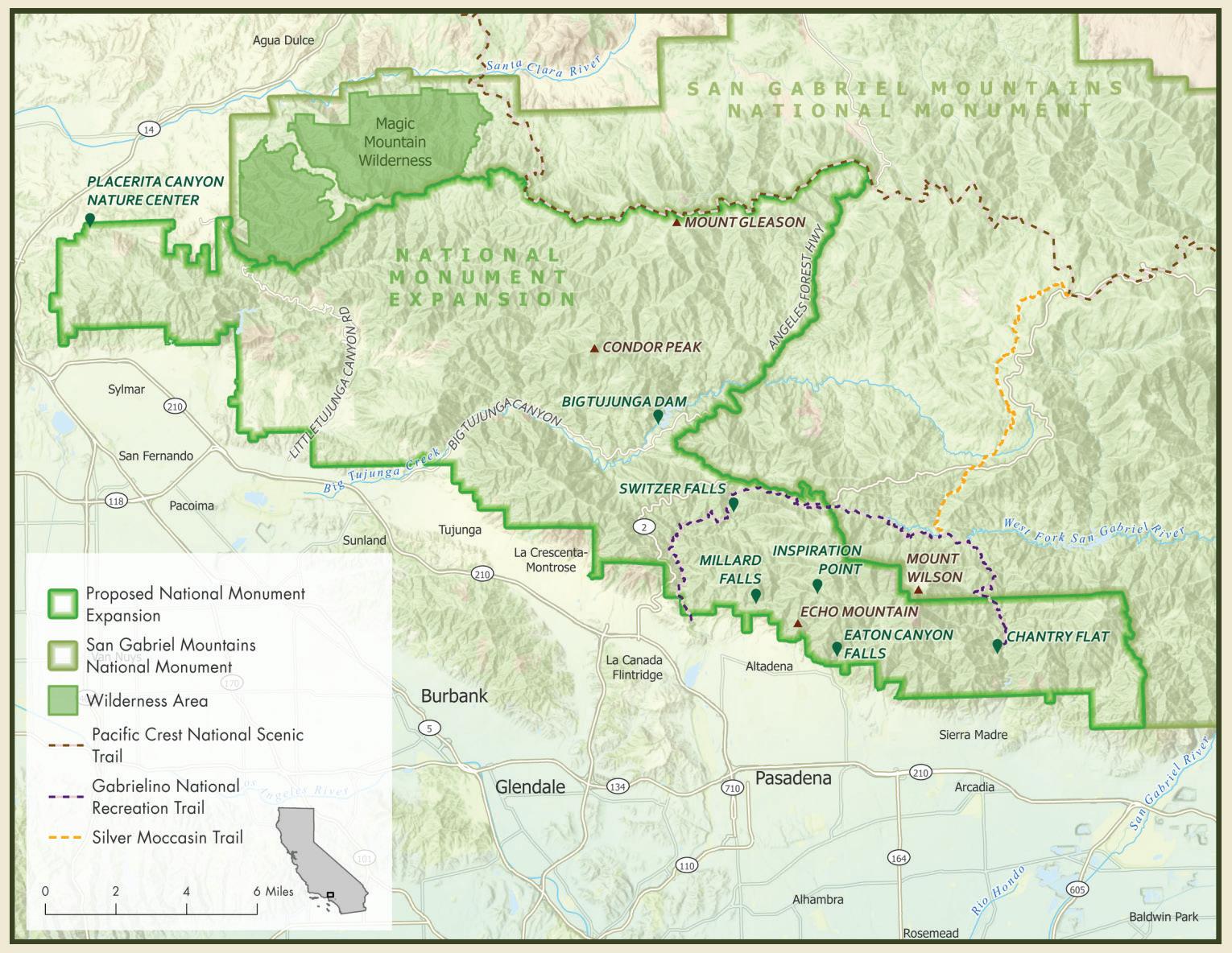
5 minute read
COLUMN: Biden is Expanding Protections for the San Gabriel Mountains. Here’s Why It’s Important
By Jaimie Ding, Editor
Just a short drive north of Alhambra is a sweeping expanse of pristine wilderness: the San Gabriel Mountains.
From Los Angeles, they tower dramatically up close over the downtown skyline, but the bustling sounds and lights of the city all but disappear once you begin your trek into the forest. Among the Douglas firs and ponderosa pines, you almost forget that you live in one of the most densely populated areas in the entire country.

I had the opportunity to see these mountains from up high when I boarded a six-seater plane and took off from the San Gabriel Valley Airport in April as part of efforts by Nature4All, a coalition of local organizations, to gain support for the expansion of the San Gabriel National Monument.
On May 2, President Joe Biden signed a proclamation to expand the monument, along with the Berryessa Snow Mountain National Monument in Sacramento.
This move comes as part of his “America the Beautiful” initiative, launched in 2021, which supports local conservation efforts around the country with a goal to conserve 30% of public lands and waters by 2030. The expansion of the two monuments is also part of the Biden administration’s commitment to honor areas of cultural significance to Tribal Nations and Indigenous peoples and expand access to nature, the White House said in a news release.
The monument, which encompasses parts of the Angeles and San Bernardino National Forests, was first established in 2014 by President Barack Obama after decades of advocacy from local groups demanding greater environmental protections for the region.
Supporters say the preservation of these public lands is an important part of increasing equitable access to nature and improving public health in Los Angeles County, which lacks parks and open space.

This was apparent when I looked down from the plane and saw the endless suburban landscape dotted with the occasional reservoir and a surprisingly large number of backyard pools and tennis courts.
The cities of the San Gabriel Valley have beautiful parks for residents to enjoy, but the mountains are the true escape. From the sky, you can’t help but marvel at the roads carving their way through rugged rock and miles and miles of tan-colored dirt trails that snake through the trees. How did we get there to build those communication towers and concrete structures in the middle of nowhere?
It’s an impressive feat, to force our way into otherwise untouched wilderness and make a statement: man and nature must learn to co-exist. To truly appreciate nature, we must venture into it. Smell the crushed pine needles under your feet. Wipe your sweat under the blistering sun. Hear the animals that peer curiously at your presence before disappearing without a trace. Only then do you realize the importance of preserving this resource for generations to come.
I landed back on the ground with newfound appreciation for the San Gabriel Mountains. That same weekend, I hiked to Josephine Peak through Colby Canyon – a beautiful 8.3 mile out-and-back trail, one of the hundreds of trails available to us in the region. Recently, I hiked the beautiful Trail Canyon Falls to a waterfall oasis nestled in the mountains. But I also realized how much of the mountains lay beyond our reach that are just as important to protect.
In May 2023, Senator Alex Padilla and Representative Judy Chu introduced legislation to expand the 346,177-acre San Gabriel Mountains National Monument by an additional 109,000 acres, which contains some of the most visited parts of the Angeles National Forest. The forest received 4.6 million visitors in 2021, according to the U.S. Forest Service, which is more than the Grand Canyon or Yosemite National Park received in the same year.
They also urged President Joe Biden to use the Antiquities Act to expand the national monument, just as Obama did. The 1906 law gives U.S. presidents the ability to designate federal public lands as national monuments with a presidential proclamation. Padilla and Chu’s legislation has been stuck in Congress.

“The Biden administration knows the value of protecting our public lands to combat climate change and ensure our communities have access to the outdoors,” Padilla said in an earlier statement. “I look forward to working with them to safeguard some of California’s most treasured natural landscapes and ensure they are around for future generations to enjoy.”
This expansion would also place sacred sites for Native American tribes, including an ancient site tied to the Fernandeño Tataviam Band of Mission Indians, under federal protection. More than 18 million people live within a 90-mile radius of the San Gabriel Mountains, and the Angeles National Forest provides one-third of the county’s drinking water.
The White House also mentioned the San Gabriel Mountains National Monument expansion area’s diversity of wildlife, including many sensitive, threatened, and endangered species. Its canyons, scrub lands, and forests provide homes to several iconic California birds, including the endangered California condor, and contains key habitats for sensitive fish and amphibians.
With Biden’s designation on May 2, the U.S. Forest Service will establish a Federal Advisory Committee to advise the development of the management plan and management of the expansion. The committee will include state agencies and local governments; Tribal nations and Indigenous communities with cultural, traditional, or ancestral ties to the area; conservation organizations; and more.











